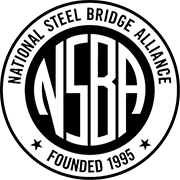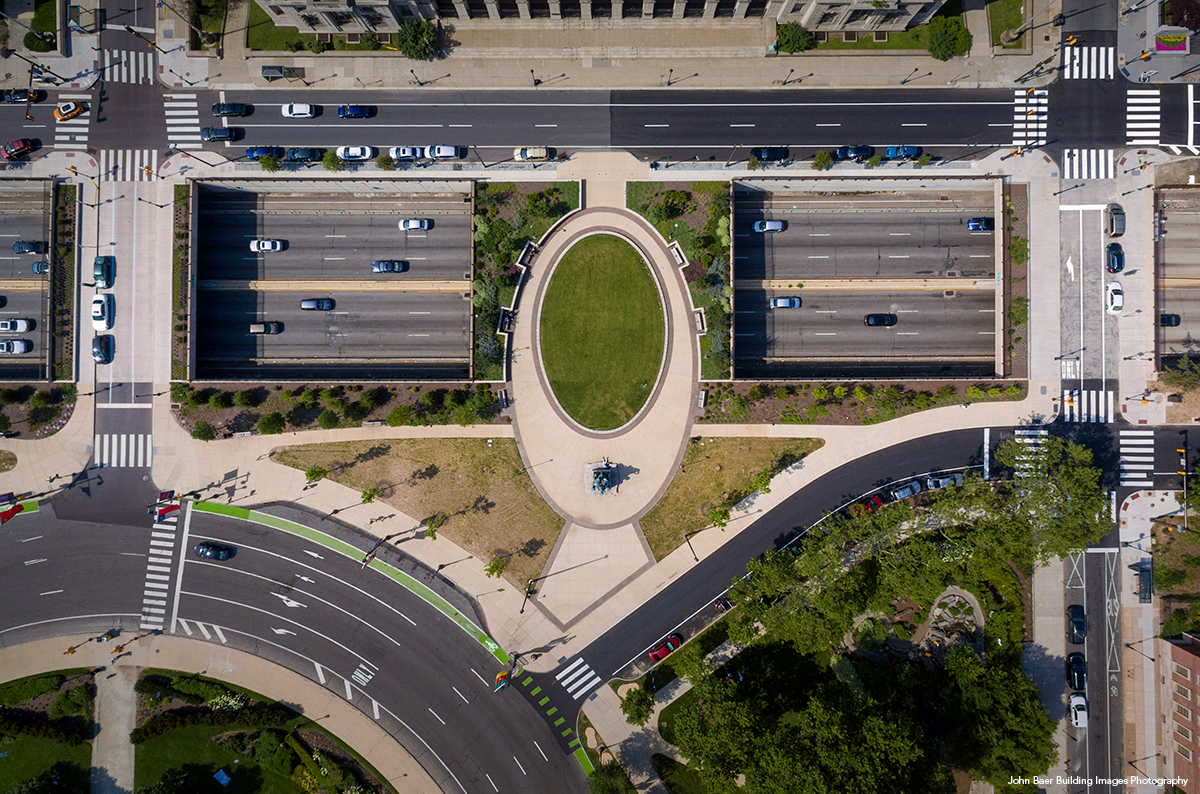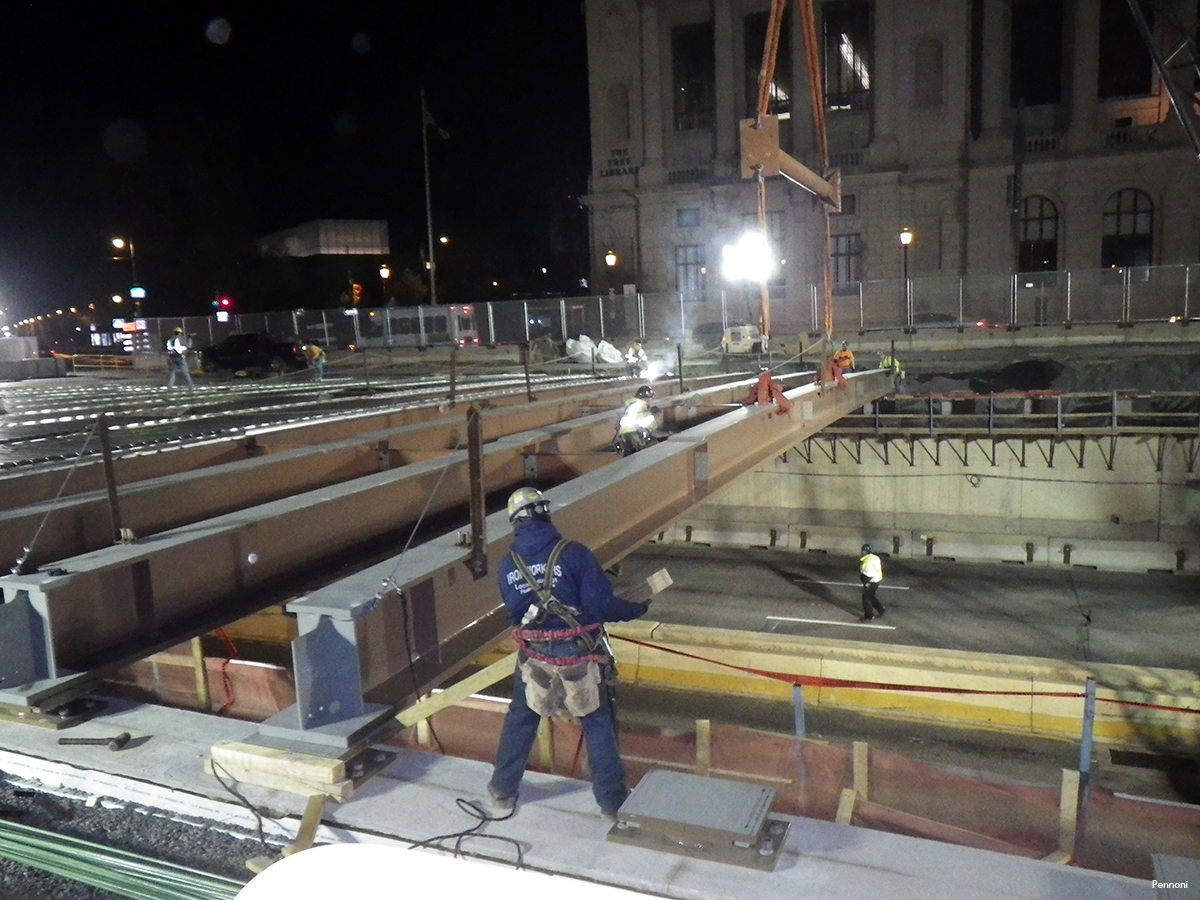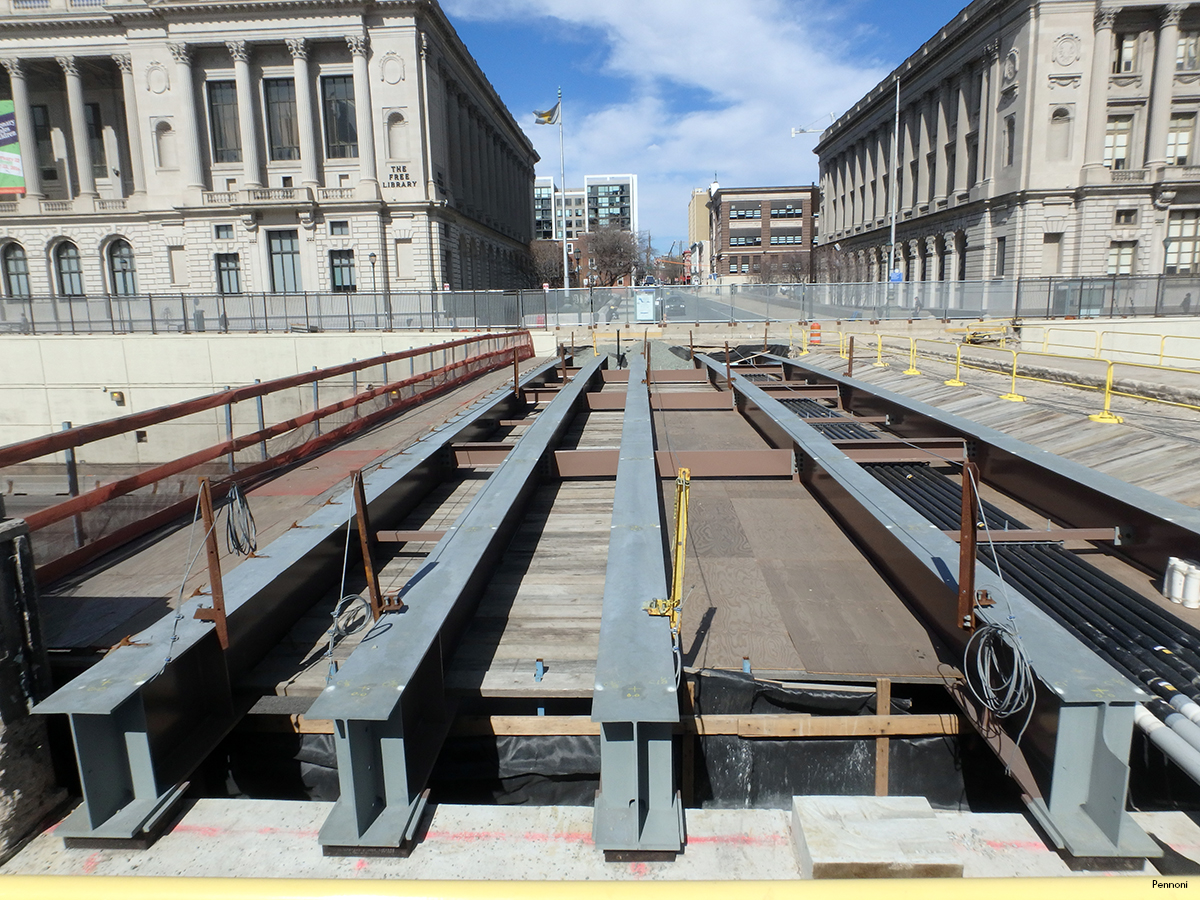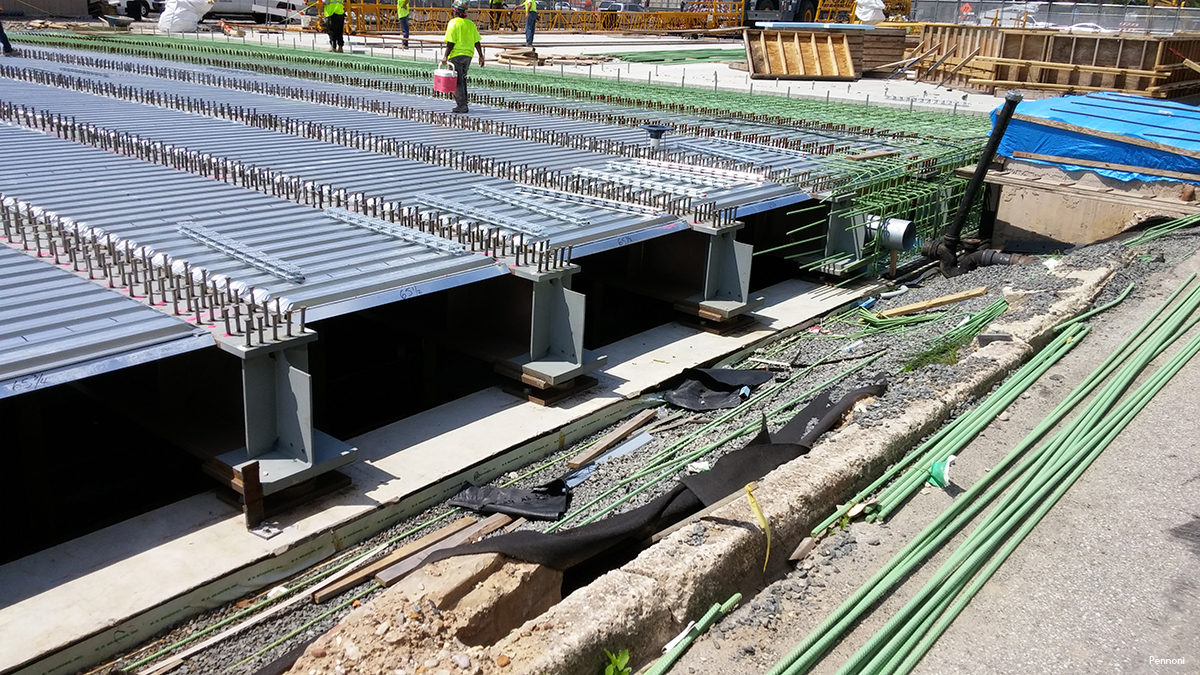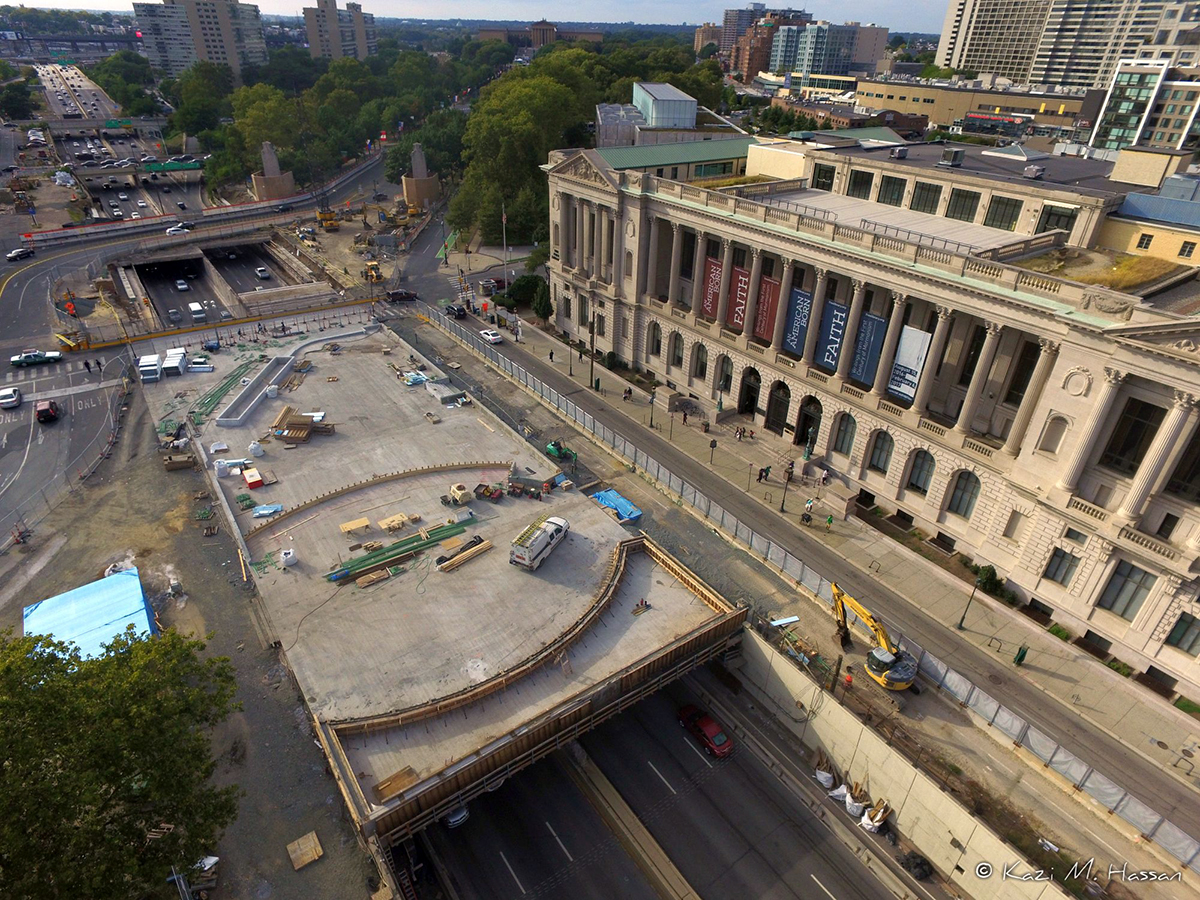National Steel Bridge Alliance
Vine Street Expressway (I-676) Bridge Reconstruction Project
National Award -- Short Span
The Vine Street Expressway is well-known to Philadelphia commuters.
The nearly two-mile stretch of Interstate 676 in the City of Brotherly Love’s downtown (aka Center City) is critical to the area’s transportation network. But in recent years, six bridges carrying local roads over the expressway were aging and suffering from significant deterioration. The Pennsylvania Department of Transportation (PennDOT) decided to replace these two-span prestressed concrete non-composite adjacent box-beam bridges with single-span welded-plate-girder steel bridges. The project considered vertical clearance issues, reuse of existing bridge abutments, relocation of several utilities supported by the bridges, and high aesthetic standards, including extensive landscaped areas and streetscape finishes atop the new structures.
Each bridge had its own challenges and unique aspects. For example, the deck for the new Family Court pedestrian bridge, located between the 18th and 19th Street bridges, is now a park for the community. This new configuration required that the bridge carry a heavier load to support trees, additional sidewalks and seating areas, and a lawn--a task for thicker flanges. But it still had to be able to flex on the bearing pads on the existing abutment and expand and contract smoothly with temperature changes. Steel was pivotal for supporting the new loads that came with these features while maintaining the clearance needed below the bridge, providing the necessary strength in a shallow profile.
The 19th Street Bridge and the four bays of utilities it supports presented a different challenge. The team prepared a steel design and construction schedule that would allow the utilities to remain in service throughout construction. The utilities were moved to temporary supports while the bridge was removed around them, then the newly fabricated beams were set in place and the utilities were relocated to the new beams while the remainder of the new bridge was built. This reduced the need for outages to move critical utilities and kept them in working order throughout the construction.
Challenging geometry drove the design of the new bridge that would combine the existing 20th Street, Ben Franklin Parkway, and Free Library Bridges into one structure: the 20th/BFP/FL Bridge. Given the sharply skewed geometry (35°) of the Parkway across the bridge, the team investigated whether the design for vehicular live loads could produce larger girder moments and shears running along the sharp skew as opposed to the typical live load configuration of vehicles traveling parallel to the girders. The team developed a 3D finite element model, which confirmed that the skewed live loading condition did not produce effects greater than the standard design vehicular loads running parallel to the girders. The resulting design yielded girders with 24-in.-deep webs and maximum 24-in.-wide by 3.5-in.-thick bottom flanges.
The 22nd Street Bridge posed particular challenges. The clearance below the bridge was too low. There was a pump station behind one of the existing abutments that could not be removed, and the bridge would have numerous existing and proposed utilities. Implementing shallow steel beams eliminated the center pier, raising the profile to the minimum 14 ft, 6 in. without exceeding the capacity of the existing abutments.
The existing concrete 18th Street Bridge carried a heavy 22-in. steam pipe below the deck. The design team worked with the local utility to employ a lighter pipe using less insulation so that the new steel span would be able to not only carry it but also fit it between the bridge beams.
Finally, the 21st Street Bridge had the longest span of all the bridge replacements due to the presence of on/off ramps below the structure, meaning that the abutments had opposing skews of up to 10° from the girder span. As such, each steel girder on this span was unique, resulting in more extensive detailing.
Project Team
-
Steel fabricator and detailer: High Steel Structures LLC, Lancaster, Pa. *AISC MEMBER* *AISC CERTIFIED*
-
Structural engineer: Pennoni, Philadelphia
-
General contractor: Buckley & Company, Inc., Philadelphia
-
Owner: Pennsylvania Department of Transportation, Harrisburg, Pa.
Prize Bridge Information
- Year Awarded: 2020
- Year Completed: 2018
- Location: Philadelphia, PA
- Award Class: Short Span
Structure Information
- Structure Type: Plate Girder
- Coating System: Paint
- Span Length (ft): 18th Street – Span 1 = 95’-2”; Family Court – Span 1 = 95’-5”; 19th Street – Span 1 = 95’-2”; 20th Street/Benjamin Franklin Parkway/Free Library – Span 1 = 95’-8”; 21st Street – Span 1 = Varies 119'-5 1⁄2” to 133’-10”; 22nd Street – Span 1 = 106’-5”
- Structure Length (ft): 18th Street = 97’-10”; Family Court = 98’-0”; 19th Street = 97’-10”; 20th Street/Benjamin Franklin Parkway/Free Library =98’-6”; 21st Street = Varies 120’-3 1⁄2” to 135’-6 7⁄8”; 22nd Street = 108’-11”
- Average Deck Width (ft): 18th Street = 69’-10 1⁄2”; Family Court = 120’-0”; 19th Street = 64’-11”; 20th Street/Benjamin Franklin Parkway/Free Library = 643’-0”; 21st Street = 67’-0”; 22nd Street = 83’-6”
- Steel Weight/Deck Area (lb/ft²): 18th Street = 0.220 Tons/SY; Family Court = 0.164 Tons/SY; 19th Street = Tons/SY; 20th Street/Benjamin Franklin Parkway/Free Library = 0.268 Tons/SY; 21st Street = 0.257 Tons/SY; 22nd Street = 0.250 Tons/SY
- Amount of Steel (tons): 2846
